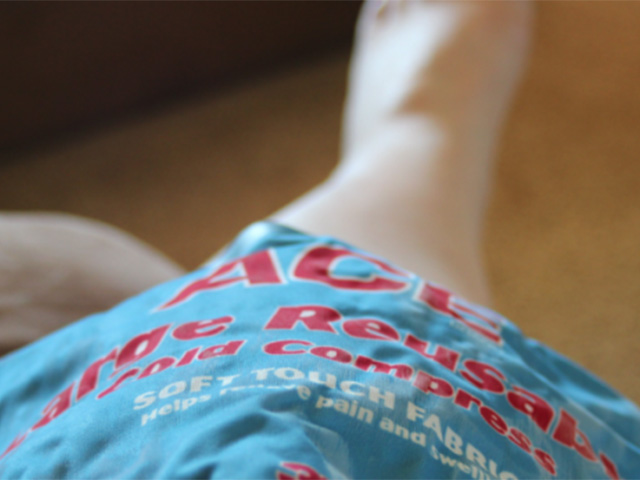Let’s say you sprain your ankle… what do you do? RICE (rest, ice, compression, elevation) and anti-inflammatories, of course! Um, well, no. I’m going to challenge your mother or father’s go-to fix and tell you to just R, within reason; C, within reason; and E, within reason. That’s right, I said to ditch the ice and anti-inflammatories!
Let me start with a little biology lesson; I’ll keep it brief. Inflammation is your body’s natural response to injury – it’s a good thing! The purpose of inflammation is to bring healing blood and nutrients to injured tissue; it helps to clear out dead and damaged cells, and begin tissue repair. Inflammation also let’s you know that your body is not happy about something. For example, if your body is mechanically “off” (poor posture, stiff joints, flat feet, etc), your body is likely using compensatory strategies to move and function. These compensatory strategies can cause a rubbing or pinching of structures. Since our bodies don’t like rubbing or pinching, it results in the onset of inflammation. Inflammation is your body’s way of communicating with you – telling you that it isn’t happy with something going on or something that has happened. Taking an anti-inflammatory or using ice is just putting a band-aid on a problem that needs to be addressed.
You’re probably saying, “but if I’m in pain, I’ll still use the ice and anti-inflammatories and just take care of the injury”. I still advise you not to, and this is why:
In a study done by Tagaki, et al, it was shown that using ice after injury caused significant permanent physiological differences to healing tissues. Tissues that received ice did not regenerate like the non-ice group; damaged muscle fibers regenerated slower and smaller, maturation of the regenerated tissues was significantly reduced, a cross-section of the regenerated muscle tissue was significantly smaller than the non-iced, and there was a noticeable amount of abnormal collagen formation (scar tissue!), while the non-ice group showed a normal amount of collagen fibers. In other words, while the icing may initially feel good, it causes permanent damage to the structures that the body is trying to repair. It has also been shown in a study done on volleyball players in 2009 that icing an injury causes decreased cytokines and anabolic hormones – naturally occurring things in our bodies that enhance athletic performance of muscles. Anti-inflammatories have the same effect of ice – they decrease inflammation in the area where tissue healing is trying to take place. Using anti-inflammatories causes all the same negative things that using ice does.
Moral of the story: I would rethink going immediately to ice and anti-inflammatories to “heal” your injury. Instead, I would recommend protecting the joint, performing small painless movements to facilitate blood flow, elevate if the injury is very painful, exercising in a pool (if possible), using Tylenol if you REALLY need to decrease pain (Tylenol is a pain reliever, but not a strong anti-inflammatory), and as always, see your favorite Physical Therapist to improve and speed up healing time!
With peace and love,
Alix Terpos PT, DPT
Resources:
http://www.caringmedical.com/sports-injuries/rice-why-we-do-not-recommend-it/
http://jap.physiology.org/content/110/2/382





 Deering Estate
Deering Estate
 Massage Envy South Miami
Massage Envy South Miami
 Calla Blow Dry
Calla Blow Dry
 My Derma Clinic
My Derma Clinic
 Sushi Maki
Sushi Maki
 Sports Grill
Sports Grill
 The Healthy Kitchen
The Healthy Kitchen
 Golden Rule Seafood
Golden Rule Seafood
 Malanga Cuban Café
Malanga Cuban Café

 Kathleen Ballard
Kathleen Ballard
 Panter, Panter & Sampedro
Panter, Panter & Sampedro
 Vintage Liquors
Vintage Liquors
 The Dog from Ipanema
The Dog from Ipanema
 Rubinstein Family Chiropractic
Rubinstein Family Chiropractic
 Your Pet’s Best
Your Pet’s Best
 Indigo Republic
Indigo Republic




 ATR Luxury Homes
ATR Luxury Homes


 2112 Design Studio
2112 Design Studio
 Hamilton Fox & Company
Hamilton Fox & Company
 Creative Design Services
Creative Design Services
 Best Pest Professionals
Best Pest Professionals
 HD Tree Services
HD Tree Services
 Trinity Air Conditioning Company
Trinity Air Conditioning Company
 Cisca Construction & Development
Cisca Construction & Development
 Mosquito Joe
Mosquito Joe
 Cutler Bay Solar Solutions
Cutler Bay Solar Solutions


 Miami Royal Ballet & Dance
Miami Royal Ballet & Dance
 Christopher Columbus
Christopher Columbus
 Pineview Preschools
Pineview Preschools
 Westminster
Westminster
 Carrollton
Carrollton
 Lil’ Jungle
Lil’ Jungle
 Frost Science Museum
Frost Science Museum
 Palmer Trinity School
Palmer Trinity School
 South Florida Music
South Florida Music
 Pinecrest Orthodontics
Pinecrest Orthodontics
 Dr. Bob Pediatric Dentist
Dr. Bob Pediatric Dentist
 d.pediatrics
d.pediatrics
 South Miami Women’s Health
South Miami Women’s Health

 The Spot Barbershop
The Spot Barbershop
 My Derma Clinic
My Derma Clinic




 Miami Dance Project
Miami Dance Project

 Rubinstein Family Chiropractic
Rubinstein Family Chiropractic
 Indigo Republic
Indigo Republic

 Safes Universe
Safes Universe
 Vintage Liquors
Vintage Liquors
 Evenings Delight
Evenings Delight





 Atchana’s Homegrown Thai
Atchana’s Homegrown Thai
 Baptist Health South Florida
Baptist Health South Florida

 Laser Eye Center of Miami
Laser Eye Center of Miami
 Visiting Angels
Visiting Angels
 OpusCare of South Florida
OpusCare of South Florida

 Your Pet’s Best
Your Pet’s Best





 HD Tree Services
HD Tree Services
 Hamilton Fox & Company
Hamilton Fox & Company


 Creative Design Services
Creative Design Services